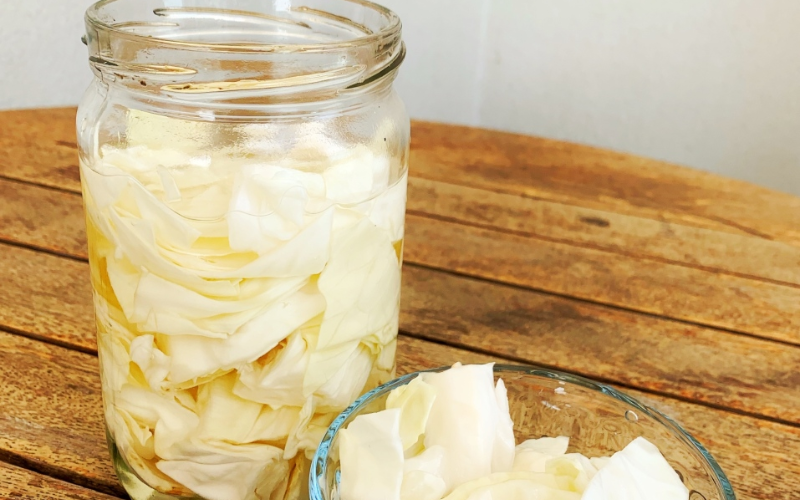Pickled cabbage, or sauerkraut, is a delicacy that has been enjoyed by gourmands for ages. The acidic flavor and crisp texture of pickled cabbage are a welcome addition to many dishes. Whether eaten alone, as a topping, or as an ingredient, this fermented delicacy has a pleasant flavor and many health benefits.
I grew up watching my grandmother and my parents preparing pickles and marmalades all the time. It is kind of a traditional heritage passed down through generations. I know how complicated it looks or maybe you have never even considered making your own pickles as they are not expensive. Believe me when I say all the store-bought pickles are including sugar and preservatives that your body doesn’t need. I promise it won’t take more than 5 minutes to prepare. If you are ready, let’s pickle whatever veggies you have at home:)
INGREDIENTS(17Kcal per serving):
- Cabbage, chunky chopped
- 4 garlic cloves, peeled
- 1 tablespoon kosher salt
- Hot water – to fill 1/2 jar
- White vinegar – to fill 1/2 jar

Sterilized glass jar
Sterilize the jar by placing it in boiling water for 1-2 minutes and letting it dry completely. Place garlic cloves on the bottom of the jar and add cabbage leaves. Stuff the jar with leaves as they will soften during the fermentation process. Mix the salt with hot water and fill the jar halfway. Fill the remaining part with white vinegar and cover it with a sterilized lid. Place the jar upside down for an hour so the lid can be sealed. The jar should not be exposed to direct sunlight or cold. After 6-7 days pickled cabbage will be ready. Once opened store in the fridge. Enjoy.
The method of pickling
- A simple method for making pickled cabbage is to ferment finely minced cabbage in a brine solution. By following these steps, beneficial bacteria can flourish, altering flavors and ultimately producing probiotics. Find below a comprehensive guide on how to pickle cabbage:
- Select a cabbage head that is bright green and feels firm to the touch. The outer leaves should be taken off and set aside. Core the cabbage and shred it using a knife or a mandolin slicer. Thin, uniform strips will promote even fermentation.
- Put the salt in a large mixing dish with the shredded cabbage and stir it around. About one to two teaspoons of salt should be used for each cabbage head of medium size. Massage the cabbage with the salt to help draw out the liquid.
- Let the cabbage sit for 15 to 20 minutes after you’ve salted it. During this resting time, the cabbage is more receptive to the salt, allowing it to penetrate deeper and extract more water.
- Put it all in a jar: Transfer the cabbage and its juices to a clean glass jar. Make sure the cabbage is completely submerged in its own liquid by pressing down firmly on it with a spoon or your hands to remove any air pockets.
- If the liquid released from the cabbage is not enough to cover it, make a brine by mixing 1 teaspoon of salt with 1 cup of filtered water. Brine the cabbage until it is totally submerged.
- Add some weight: You can use a small plate or a fermentation weight to keep the cabbage submerged and out of the air as it ferments. Because of this, an anaerobic environment is more likely to be maintained, which is crucial for productive fermentation.
- Cover the jar with a clean cloth or a fermentation lid to allow gas to escape while keeping dust and insects out during the fermentation process and waiting period. Leave the jar in a cold, dark place for about a week or two, depending on how sour you want it to be.
- After the pickled cabbage has fermented for the first time, it can be tasted and stored. If the desired tartness has been reached, store it in the fridge. By keeping everything at a low temperature, you may keep the flavors locked in and slow down the fermentation process. Pickled cabbage has a long shelf life in the fridge, up to a few months.
Advantages and flexibility:
- Pickled cabbage is versatile in the kitchen and good for you. Here are a few reasons why you should incorporate pickled cabbage into your diet:
- Pickled cabbage adds a sour and acidic note to many dishes, making them taste even better. It’s a great complement to salads, hot dogs, and sausages, among other foods.
- The fermenting process used to make pickled cabbage results in helpful bacteria that help maintain a healthy gut microbiome and efficient digestion.
- Vitamins C and K, in addition to fiber, are preserved during the pickling process in cabbage.
- Pickled cabbage has a long storage life, making it a convenient and readily available component. It may be kept fresh for months if refrigerated properly.
NOTES:
- Measurements are for 500 ml jar. You can double or reduce the amounts based on your jar.
- If you will pickle cucumber do not slice them and keep it no longer than 4-5 days.
- I ordered the vinegar online as our local store is out of stock at the moment.
If you try this recipe, please share your comments with me. Stay safe.

